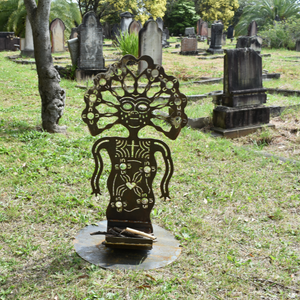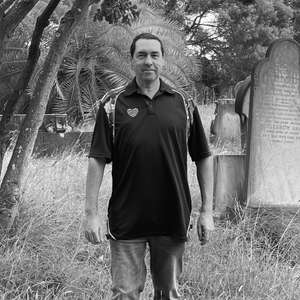Mani (2022)
Laser cut steel and concrete

Dharug language Mani means ghost, apparition or spirit. As a Dharug artist, I feel it is very important to have our art show on our land. Rookwood is on Dharug Country. Mani is a spirit designed in the old way, made in the new way using laser cutting machines. The spirits protect us and look after our people and clans.
About the Artist

Adam King is a proud Dharug man who currently lives on Guringai Country, Central Coast NSW. He started his art practice 30 years ago when living in Sydney. Adam was taught by professional artists, learning his skills in the old traditional ways. Over the years he has also been learning about culture and the way of life of his people and the respect of this land. Adam has also worked in building, construction, and design, using CAD software, plasma cutters and CNC Waterjet Cutting Machines. By bringing his art, construction, metal working and CAD design skills together, Adam creates strong statements. He hopes to teach the next generation, to open-up careers and job opportunities for Aboriginal young people.
Transcription
My name is Adam King and my artwork is called Mani. Could say it's actually an aboriginal spirit.
Has a smoking ceremony underneath it. So I designed it for as a good spirit and I designed it with people from clans all coming together in the middle of the love heart to represent the cemetery, to say as a gathering point, and so I was telling a story tribes and clans coming together for a special occasion, and then I put the smoking underneath it. Idea with that is to cleanse your body and it's very important for us to have that in our culture.
And so yeah, so it's something very special. The artistic was actually trying to design something out of metal that's going to last for a very long time. So I want eventually this to be used more than once, because we don't have anything like this. We have a lot of smoking ceremony done with traditional timber. The problem with that they burn out all the time. So I wanted to invent something that would not burnt out and it could be used over and over. Probably the first time it's probably ever done, and I'd like to be creative and try to do things that people don't do. Um and the arts made out of steel, so it's going to be robust, it's gonna last for a long time.
So it's very important to make it last and make it so it's durable. It's probably the most important thing with this. So to actually make this artwork. It's done by using drawing programs, which I run a fair bit. So it was actually fully on designing using CAD programs and then using graphics software. So we've come up the design on that, which we change and swap until we are happy with the design. And then after that, once we're happy with it, we shaped it and made sure it's a decent size and stuff, and then it's the procedure of getting on a CNC machine, which is a cutting machine which cuts it all out, and that's how we get all our shapes and get everything looking perfect.
The next thing we did was the base. We do a nice big solid base at a six mill plates, so the whole jobs out of six mill plate. So we weld that directly onto that. The stiffens that up and on the front of that we put our smoking ceremony, which we've folded so it looks like a traditional bit of timber so it doesn't have the ends closing because wood don't have the ends closing, they have the ends open. So we're trying to make that all look traditional. So this work's is just not for Rookwood Cemetery it will work in any cemetery because it has a smoking thing in it, which is a really powerful message, especially with the Aboriginal community and I have the spirit which is really high in the Aboriginal community. So it's a very special piece of artwork for most cemeteries because it's something new and no one's done it and it's really important that we have new products and new range and have this put in the place we'd never have it. We don't have it. So that's very special to the cemetery.
And so the artwork is up the top, which is a circle with a half a horseshoe. They mean men and when you come down the face and then you see the tears of sadness because we just lost someone, and then you follow it down and then you get around circle, which means a gathering point. Then you've got a horseshoe shape with a strike. That means females and then they all come down to the heart. That represent the person has passed away and that represent with sadness because we have lost someone. So the artwork is actually telling a whole story from the top down to the bottom, so you can follow the story. But the top is actually designed like a traditional spirit on rocks. So when you look at Aboriginal spirits on rocks, you can see that is actually done in the artwork. So we've done traditional artwork but in modern techniques.
Okay, I want them to take away understanding the story and the artwork it's probably more important. So I would like you to understand what the shapes mean and the storytelling so you can understand what we're trying to achieve. And should I take away that the smoking ceremony is very important. It's cleaning the body. You can understand that's part of our culture and it starts to stay our culture everything. Everyone can enjoy that and invited to do that. So it's gonna to embrace that and everyone to understand what the culture is and what the art works about.